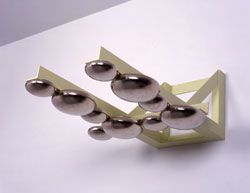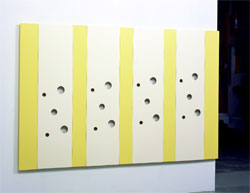
|
||
|
Portland art blog + news + exhibition reviews + galleries + contemporary northwest art
|
||
Richard Rezac at the Portland Art Museum 
Richard Rezac, Untitled (98-06), 1998, Nickel plated bronze and steel, Collection of Sarah and Andrew Meigs Whenever I move to a new place it is easy for me to take it for how I’ve found it, believing in a permanency that seldom exists. I see it, so it must have been true for all time. As a newcomer, I have had to remind myself that the Jubitz Center for Modern and Contemporary Art in the Mark Building at the Portland Art Museum hasn’t always been there. Knowing that there was a void that has since been filled has left me wondering how I would feel about my new home had there not been a place to study a large collection of contemporary work. It is something, I just realized, I have never had to deal with most of my adult life. Not a major hardship, in the least, but I do feel a bit of dumb-luck that I didn’t have to wait through renovations for this collection and programming to makes it’s way onto the walls of the Mark Building. It’s a promising resource that I will make a point to support. With that, please forgive my feelings of fortune again with the recently opened Richard Rezac show at the Museum. Though promoted with little fanfare (there still is no mention of the show on PAM's website and no listing in the Oregonian's A&E section today), the third show in the new Miller Miegs series marks a return to the Pacific Northwest for an artist whose modest constructions and drawings occupy the gallery with a vigorous hush. The sculpture is tidy; its surface flawless at a distance, as if machined. Much like that distanced view, photographs of the pieces are slick, masking what makes this work so warm. Their design requires you to inhabit the same space in order to realize its premise. Part of that premise, or at least the part that draws my attention, is the tension of what curator Bruce Guenther calls “perceptual tests.” ”Something”, according to Mr. Guenther, “is revealed with each movement of the body.” Movement towards a piece reveals not perfection, but a surface worked by hand. What is evident from that hand is studied imperfection. The artist touched this and wants you to know it. There are evident brushstrokes, odd painted over marks in material, oil from fingerprints etched into the surface of metal. Not only that but the geometry, so studied and exact on one view suddenly becomes awkward and out of balance on another. A search for the pattern to return requires movement, constant movement and attention. There is an anxious desire to touch, tip, sand, buff and reposition the work that puts one in a mild frenzy. Social protocol and its placement within an institution prevent such an activity. Even if one were to cross over, there is a futility in that desire. It’s made evident with that movement around the work. Tension sparks within the viewers body and it becomes mildly obsessive. The focus shifts, and an internal dialogue takes over. There must be metaphors for larger issues of powerless participation at hand and the sobering, quiet elegance with which they request my attention causes me to slip into a state of ecstatic sadness. Then I land, crack my head on its humor and that wistful feeling ends. 
Richard Rezac, Untitled (02-06), 2002, painted wood and aluminum, 46 x 72.5 x 1.5". Courtesy of artist (and Rhona Hoffman Gallery, Chicago) Mr. Rezac will be off to Rome soon. As one of the recipients of this year’s Rome Prize he will be able to study one of the styles of architecture he favors most by mere geographic location since Baroque architecture litters the city. I had a chance to speak with Mr. Rezac at the opening and before that via email. He spoke of his excitement for his travels and for those with whom he shares the prize. In particular he spoke of the Head of Objects Conservation at the Museum of Fine Arts in Boston. Her proposal was entitled “Artists Using Architecture: Exploring the Relationship between Architecture, Contemporary Art, and Conservation”. They both most surely will benefit from this meeting. Because his project proposal was entitled “Shared Visual Language: Sculpture – Architecture” I wrote him a couple of questions before the opening pertaining to that. What is that shared visual language that you refer to between sculpture and architecture that might not be obvious? “Geometric form is the obvious shared language between architecture and my sculpture, which is essentially abstract. The non-obvious shared language is undoubtedly many, but one is human scale, seen easily in fragments or details in architecture (since all buildings are meant to conform for use), and by inference in my sculpture. Recently for me, repetition and pattern have entered my sculpture in a significant way, and architecture generally relies on units, both structural and decorative.” What's the building in Chicago that impresses you most? “In Chicago, I most often marvel at the Monadnock Building by John Root.” Because of that interest in Baroque architecture this may seem like an odd choice. Built between 1889 and 1893 the Monadnock’s mix of wall bearing construction on it’s northern half and steel frame construction on the south, pointed to an end and a beginning in architecture’s history. It seems an appropriate choice given that Mr. Rezac’s work borrows, bridges and points from where we are to something new. |

